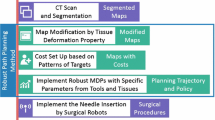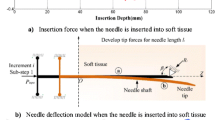Abstract
Purpose
Flexible needle insertion is an important minimally invasive surgery approach for biopsy and radio-frequency ablation. This approach can minimize intraoperative trauma and improve postoperative recovery. We propose a new path planning framework using multi-goal deep reinforcement learning to overcome the difficulties in uncertain needle–tissue interactions and enhance the robustness of robot-assisted insertion process.
Methods
This framework utilizes a new algorithm called universal distributional Q-learning (UDQL) to learn a stable steering policy and perform risk management by visualizing the learned Q-value distribution. To further improve the robustness, universal value function approximation is leveraged in the training process of UDQL to maximize generalization and connect to diagnosis by adapting fast re-planning and transfer learning.
Results
Computer simulation and phantom experimental results show our proposed framework can securely steer flexible needles with high insertion accuracy and robustness. The framework also improves robustness by providing distribution information to clinicians for diagnosis and decision making during surgery.
Conclusions
Compared with previous methods, the proposed framework can perform multi-target needle insertion through single insertion point qunder continuous state space model with higher accuracy and robustness.





Similar content being viewed by others
References
Hamad GG, Curet M (2010) Minimally invasive surgery. Am J Surg 199(2):263–265
Tan X, Chng C-B, Ye S, Lim K-B, Chui C-K (2019) Robot-assisted training in laparoscopy using deep reinforcement learning. IEEE Robot Autom Lett 4(2):485–492
Hiraki T, Kamegawa T, Matsuno T, Sakurai J, Kirita Y, Matsuura R, Yamaguchi T, Sasaki T, Mitsuhashi T, Komaki T (2017) Robotically driven ct-guided needle insertion: preliminary results in phantom and animal experiments. Radiology 285(2):454–461
Abolhassani N, Patel R, Moallem M (2007) Needle insertion into soft tissue: a survey. Med Eng Phys 29(4):413–431
Schaul T, Horgan D, Gregor K, Silver D (2015a) Universal value function approximators. In: International conference on machine learning. pp 1312–1320
Tan X, Yu P, Lim K-B, Chui C-K (2018) Robust path planning for flexible needle insertion using Markov decision processes. Int J Comput Assist Radiol Surg 13(9):1439–1451
Duan B, Wen R, Chng C-B, Wang W, Liu P, Qin J, Peneyra JL, Chang SK-Y, Heng P-A, Chui C-K (2015) Image-guided robotic system for radiofrequency ablation of large liver tumor with single incision. In: 2015 12th International conference on ubiquitous robots and ambient intelligence (URAI). IEEE, pp 284–289
DiMaio SP, Salcudean SE (2005) Needle steering and motion planning in soft tissues. IEEE Trans Biomed Eng 52(6):965–974
Taylor RH, Menciassi A, Fichtinger G, Fiorini P, Dario P (2016) Medical robotics and computer-integrated surgery. In: Siciliano B, Khatib O (eds) Springer handbook of robotics. Springer, Cham, pp 1657–1684
Liu P, Qin J, Duan B, Wang Q, Tan X, Zhao B, Jonnathan PL, Chui C-K, Heng P-A (2018) Overlapping radiofrequency ablation planning and robot-assisted needle insertion for large liver tumors. Int J Med Robot Comput Assist Surg 15:e1952
Chatelain P, Krupa A, Navab N (2015) 3d ultrasound-guided robotic steering of a flexible needle via visual servoing. In: IEEE international conference on robotics and automation, ICRA’15
Alterovitz R, Siméon T, Goldberg KY (2007) The stochastic motion roadmap: a sampling framework for planning with Markov motion uncertainty. In: Robotics: science and systems, vol 3, pp 233–241
Alterovitz R, Branicky M, Goldberg K (2008) Motion planning under uncertainty for image-guided medical needle steering. Int J Robot Res 27(11–12):1361–1374
Morar A, Moldoveanu F, Gröller E (2012) Image segmentation based on active contours without edges. In: 2012 IEEE 8th international conference on intelligent computer communication and processing. IEEE, pp 213–220
Chen X, Nguyen BP, Chui C-K, Ong S-H (2016) Automated brain tumor segmentation using kernel dictionary learning and superpixel-level features. In: 2016 IEEE international conference on systems, man, and cybernetics (SMC). IEEE, pp 002547–002552
Sutton RS, Barto AG (1998) Introduction to reinforcement learning, vol 135. MIT Press, Cambridge
Deng L, Yu D (2014) Deep learning: methods and applications. Found Trends® Signal Process 7(3–4):197–387
Silver D, Schrittwieser J, Simonyan K, Antonoglou I, Huang A, Guez A, Hubert T, Baker L, Lai M, Bolton A (2017) Mastering the game of go without human knowledge. Nature 550(7676):354
Schulman J, Wolski F, Dhariwal P, Radford A, Klimov O (2017) Proximal policy optimization algorithms. arXiv:1707.06347
Fu YB, Chui CK, Teo CL (2013) Liver tissue characterization from uniaxial stress–strain data using probabilistic and inverse finite element methods. J Mech Behav Biomed Mater 20:105–112
Fu YB, Chui CK (2014) Modelling and simulation of porcine liver tissue indentation using finite element method and uniaxial stress–strain data. J Biomech 47(10):2430–2435
Qu C, Mannor S, Xu H (2018) Nonlinear distributional gradient temporal-difference learning. arXiv:1805.07732
Bellemare MG, Dabney W, Munos R (2017) A distributional perspective on reinforcement learning. arXiv:1707.06887
Andrychowicz M, Wolski F, Ray A, Schneider J, Fong R, Welinder P, McGrew B, Tobin J, Abbeel OP, Zaremba W (2017) Hindsight experience replay. In: Advances in neural information processing systems, pp 5048–5058
Schaul T, Quan J, Antonoglou I, Silver D (2015b) Prioritized experience replay. arXiv:1511.05952
Tamar A, Di Castro D, Mannor S (2016) Learning the variance of the reward-to-go. J Mach Learn Res 17(1):361–396
Yang L, Wen R, Qin J, Chui C-K, Lim K-B, Chang SK-Y (2010) A robotic system for overlapping radiofrequency ablation in large tumor treatment. IEEE/ASME Trans Mechatron 15(6):887–897
Tan X, Chng C-B, Duan B, Ho Y, Wen R, Chen X, Lim K-B, Chui C-K (2017) Cognitive engine for robot-assisted radio-frequency ablation system. Acta Polytech Hung 14(1):129–145
Tan X, Chng C-B, Duan B, Ho Y, Wen R, Chen X, Lim K-B, Chui C-K (2016) Design and implementation of a patient-specific cognitive engine for robotic needle insertion. In: 2016 IEEE international conference on systems, man, and cybernetics (SMC). IEEE, pp 000560–000565
Van Hasselt H, Guez A, Silver D (2016) Deep reinforcement learning with double Q-learning. In: AAAI, vol 16, pp 2094–2100
Wasserstein RL, Lazar NA (2016) The asa’s statement on p values: context, process, and purpose. Am Stat 70(2):129–133
Leong F, Huang W-H, Chui C-K (2013) Modeling and analysis of coagulated liver tissue and its interaction with a scalpel blade. Med Biol Eng Comput 51(6):687–695
Tokuda J, Song S-E, Fischer GS, Iordachita II, Seifabadi R, Cho NB, Tuncali K, Fichtinger G, Tempany CM, Hata N (2012) Preclinical evaluation of an MRI-compatible pneumatic robot for angulated needle placement in transperineal prostate interventions. Int J Comput Assist Radiol Surg 7(6):949–957
Krieger A, Susil RC, Fichtinger G, Atalar E, Whitcomb LL (2004) Design of a novel MRI compatible manipulator for image guided prostate intervention. In: IEEE international conference on robotics and automation, proceedings on ICRA’04, vol 1. IEEE, pp 377–382
Schouten MG, Ansems J, Renema WKJ, Bosboom D, Scheenen TWJ, Fütterer JJ (2010) The accuracy and safety aspects of a novel robotic needle guide manipulator to perform transrectal prostate biopsies. Med Phys 37(9):4744–4750
Acknowledgements
The last author would like to acknowledge the contribution of A/Prof Stephen Chang of Mount Elizabeth Hospital, Singapore for his input on surgeries and medical education.
Funding
The research and development of the prototype Image-guide Radio-frequency Ablation Surgical System was supported in parts by Research Grants from Singapore Agency of Science and Technology (A*Star) and Ministry of Education, Singapore respectively.
Author information
Authors and Affiliations
Corresponding author
Ethics declarations
Conflict of interest
The authors declare that they have no conflict of interest.
Informed consent
Informed consent was obtained from all individual participants included in the study.
Human and animal rights
All procedures performed in studies involving human participants were in accordance with the ethical standards of the institutional and/or national research committee and with the 1964 Helsinki declaration and its later amendments or comparable ethical standards.
Additional information
Publisher's Note
Springer Nature remains neutral with regard to jurisdictional claims in published maps and institutional affiliations.
Rights and permissions
About this article
Cite this article
Tan, X., Lee, Y., Chng, CB. et al. Robot-assisted flexible needle insertion using universal distributional deep reinforcement learning. Int J CARS 15, 341–349 (2020). https://doi.org/10.1007/s11548-019-02098-7
Received:
Accepted:
Published:
Issue Date:
DOI: https://doi.org/10.1007/s11548-019-02098-7




